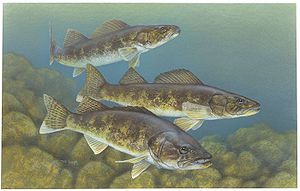Walleyes
| Walleye | |
|---|---|
 |
|
| Scientific classification | |
| Kingdom: | Animalia |
| Phylum: | Chordata |
| Class: | Actinopterygii |
| Order: | Perciformes |
| Family: | Percidae |
| Genus: | Sander |
| Species: | S. vitreus |
| Binomial name | |
|
Sander vitreus (Mitchill, 1818) |
|
| Subspecies | |
|
|
Walleye (Sander vitreus, formerly Stizostedion vitreum) is a freshwater perciform fish native to most of Canada and to the Northern United States. It is a North American close relative of the European Zander, also known as the pikeperch. The walleye is sometimes called the yellow walleye to distinguish it from the blue walleye, which is a subspecies that was once found in the southern Ontario and Quebec regions, but are now presumed extinct. However, recent genetic analysis of a preserved (frozen) 'blue walleye' sample suggests that the blue and yellow walleye were simply phenotypes within the same species and do not merit separate taxonomic classification.
In some parts of its range, the walleye is known as the walleyed pike, colored pike, yellow pike or pickerel (esp. in English-speaking Canada), although the fish is not related to other species of pikes which are members of the family Esocidae.
Walleyes show a fair amount of variation across watersheds. In general, fish within a watershed are quite similar and are genetically distinct from those of nearby watersheds. The species has been artificially propagated for over a century and has been planted on top of existing populations or introduced into waters naturally devoid of the species, sometimes reducing the overall genetic distinctiveness of populations.
The common name, "walleye", comes from the fact that the fish's eyes point outward, as if looking at the walls. This externally facing orientation of the eyes gives anglers an advantage in the dark because there is a certain eyeshine given off by the eye of the walleye in the dark, similar to that of lions and other night dwelling animals. This "eyeshine" is the result of a light-gathering layer in the eyes called the tapetum lucidum, which allows the fish to see well in low-light conditions. In fact, many anglers look for walleyes at night since this is when major feeding patterns occur. The fish's eyes also allow them to see well in turbid waters (stained or rough, breaking waters), which gives them an advantage over their prey. Thus, walleye anglers will commonly look for locations where there is a good "walleye chop" (i.e., rough water). This excellent vision also allows the fish to populate the deeper regions in a lake, and they can often be found in deeper water, particularly during the warmest part of the summer.
...
Wikipedia

